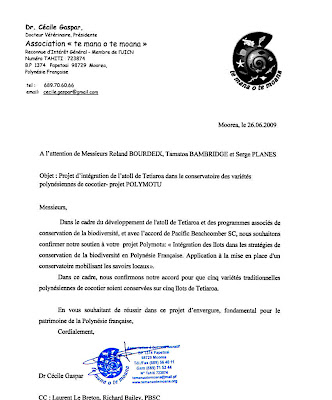 |
| Kakato birds in captivity |
Polymotu concept is to use geographical and reproductive isolation to conserve and reproduce varieties of plants and trees. When a small isolated place is planted all with the same variety, the plants conserved there breed only within the same variety, and certified seed and seednuts can be produced at the lower cost. These isolated places can be small islands or small valleys; they can also be located in flat mainland, with landscaping designed to create pollen barriers.
We discussed about Polymotu concept with Dr Jean-Dominique Lebreton, the director of the Centre for Functional and Evolutional Ecology at Montpellier, France. Then Dr Lebreton made a very interesting connection between Polymotu and what is achieved in New Zealand in the field of conservation of endangered birds.
Humans have had a profound effect on many bird species. Over one hundred species have gone extinct in historical times, although the most dramatic human-caused extinctions occurred in the Pacific Ocean as humans colonised the islands, during which an estimated 750-1800 species of bird went extinct. According to Worldwatch Institute, many bird populations are currently declining worldwide, with 1,200 species facing extinction in the next century.
Translocations involve moving populations of threatened species into areas of suitable habitat currently unused by the species. There are several reasons for doing this; the creation of secondary populations that act as an insurance against disaster, or in many cases threats faced by the original population in its current location.
 |
| Kakato Bird in the wild |
One famous translocation was of the Kakapo of New Zealand. The kakapo (Strigops habroptilus Gray 1845) is a large, flightless, nocturnal parrot, endemic to New Zealand. Once abundant throughout New Zealand, the whole population in the wild was reduced to approximately 50 individuals. In situ conservation of natural populations has proved impracticable. These large flightless parrots were unable to cope with introduced predators, such as rats and cats in their remaining habitat on Stewart Island.
Between 1974 and 1992, kakapo birds were translocated to four of New Zealand's offshore islands (Maud, Little Barrier, Codfish, and Mana). Few, if any, kakapo now remain within their former range. Regular monitoring and intensive management of the translocated populations is being undertaken. In April 1998, a total population of fifty-six kakapo was known to survive on offshore islands.
 |
| Maud Island in New Zealand |
Twenty-six kakapo, thirteen males and thirteen females, were temporarily transferred to Pearl Island (518 ha), southern Stewart Island, from April 1998 to April 1999. The translocation of kakapo to Pearl Island, and subsequent breeding season, provided an ideal experimental framework to study kakapo dispersal, movement patterns, home range development, habitat selection, and lek development during the non-breeding and breeding seasons (Leigh, 2009). The study have shown that Kakapo selected habitat mosaics and vegetation types with higher species diversity and moderate to high abundance of mature rimu and yellow silver pine trees.
 |
| Codfish Island in New Zealand |
Of course, we cannot plant coconut palms in New Zealand, because the weather is too cold. This was one of the great sadness of the
Maori people - they tried so many times to plant coconut palms when arriving from their tropical islands. Anyways, we can use as an example what Kiwis and Maoris did for bird, and apply it to the coconut palm and other species in our warmer islands.
Reference.
Joyce, L. (2008) Movement patterns, home range and habitat selection by kakapo (Strigops habroptilus, Gray 1845) following translocation to Pearl Island, Southern New Zealand. Phd Thesis, University of Otago, Neaw Zealand.





.jpg)
